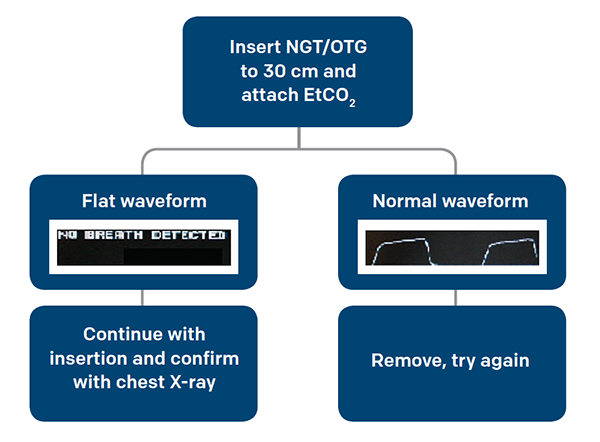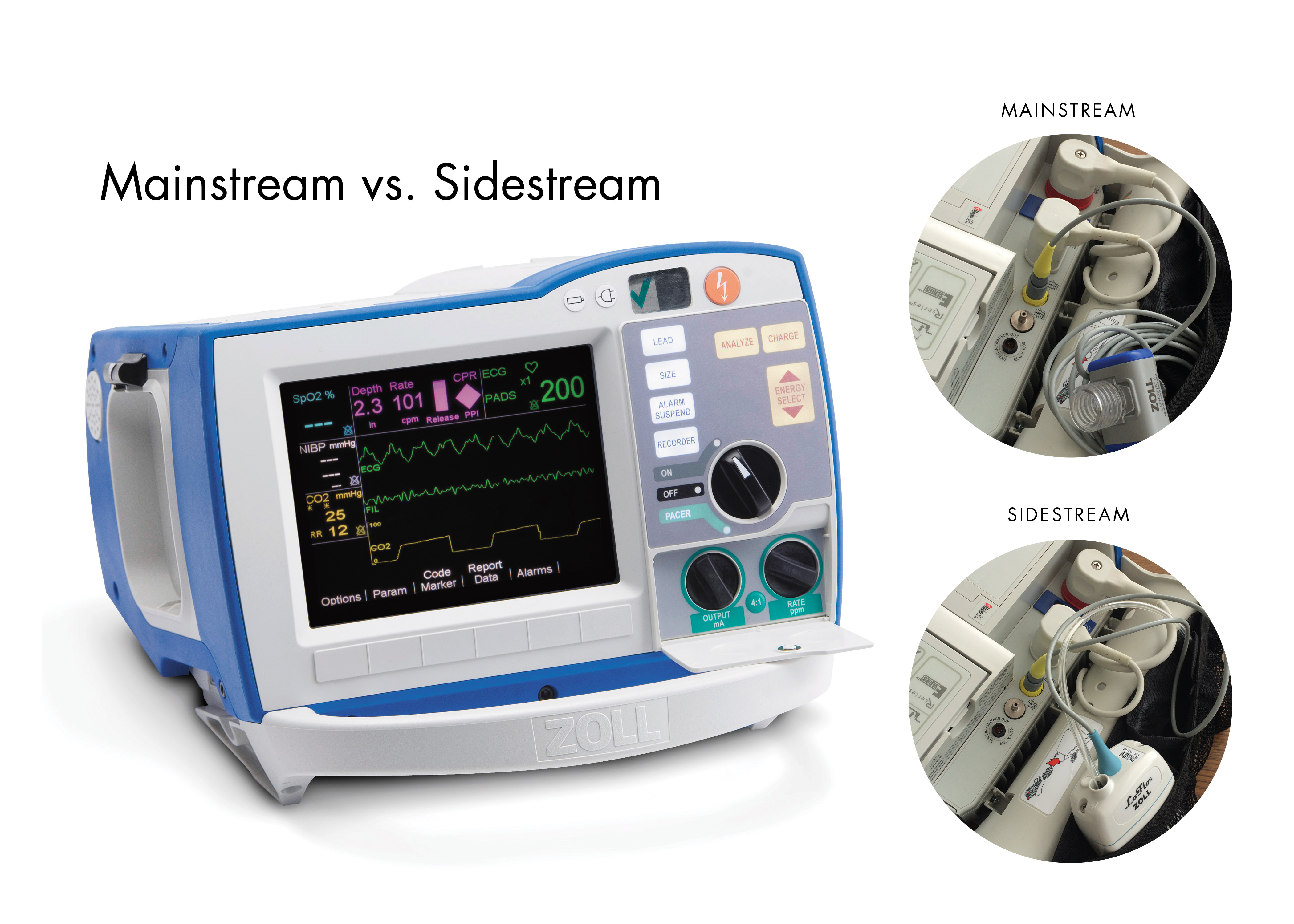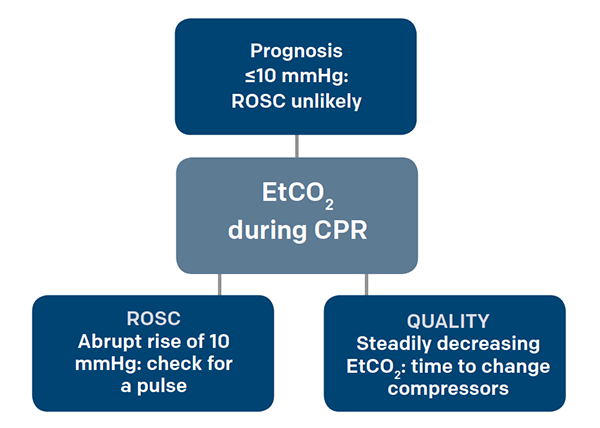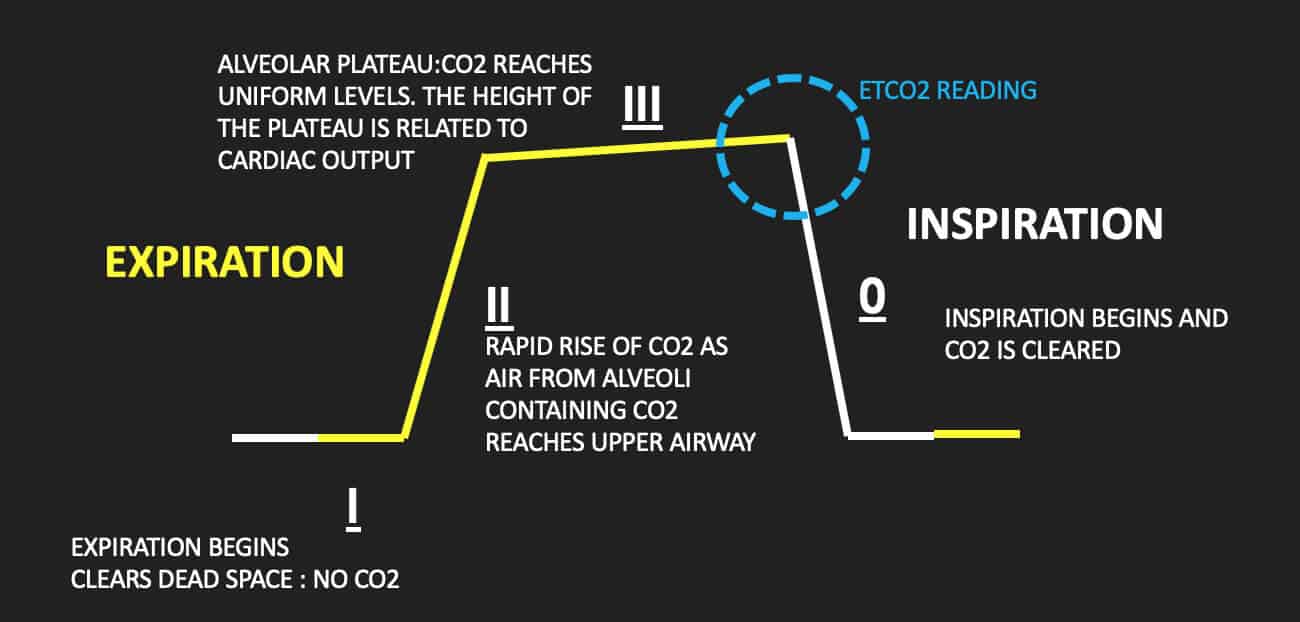end tidal co2 range cpr
EtCO 2 levels have been shown to correlate. Total pressure of a gas is the sum of the partial pressures of the gas Expired CO2 measured PetCO2 mmHg in waveform Percentage Normal Levels PaO2 85-100mmHg PaCO2 35-45mmHg Percentage vs.

Use End Tidal Capnography For Placing Orogastric Nasogastric Tubes And Cpr Page 2 Of 4 Acep Now Page 2
10 mmHg during CPR in an intubated patient suggests that the quality of chest compressions needs improvement.

. Chest compression provider tiring end-tidal CO2 value diminishes over time. An increase in etCO2 by 5 appears to have reasonable sensitivity 71-91 and specificity 94-100 for fluid responsiveness in two studies of patients breathing passively on the ventilator. 1 evaluating the effectiveness of chest compressions and 2 identification of ROSC.
After 20 minutes of CPR death occurs if ETCO2 is consistently below 10 mmHg with 100 sensitivity and specificity 15. Remember a normal end-tidal is between 35 and 45. EtCO2 is essentially to ensuring quality CPR.
Gradual fall in ETCO2 suggests compressionist fatigue during CPR - time to change compressionists. 428 153 mmHg versus 323 141 mmHg. Based upon existing evidence ETCO 2 levels do seem to provide limited prognostic information for patients who have experienced cardiac arrest.
This will cause a decrease in the ETCO2 end-tidal CO2 and this will be observable on the waveform as well as with the numerical measurement. MEASURING END-TIDAL CO 2 LEVELS DURING CARDIAC ARREST. Attach the in-line connector to the breathing circuit ensuring that a bacterialviral filter is connected to the airway adjunct maskLMAETT.
The waveform is called capnograph and shows how much CO 2 is present at each phase of the respiratory cycle. During cardiopulmonary resuscitation CPR adequate chest compressions generate a cardiac output of 17 to 27 allowing CO 2 circulation for exhalation. However in ACLS and in a cardiac arrest Im using end-tidal not necessarily for the pulmonary or respiratory status but to look at the function of the pump the function of the heart.
ETCO2 is a reliable indicator with a high prognostic value in determining the CPR outcome 11 12. In the field monitoring ETco 2 during endotracheal-tube placement can verify correct tube placement and indicate tube dislodgement during transport. Waveform capnography also known as end-tidal carbon dioxide EtCO 2 is a unique tool for evaluating patient metabolism circulation and ventilation.
78 Nitrogen 21 Oxygen 1 CO2 and other gases Exhaled gases. Initial ETCO 2 or 20-min ETCO 2 20mmHg appears to be a better predictor of ROSC than the 10mmHg cut off value. Normal ETCO2 in the adult patient should be 35-45 mmHg.
NaHC03 will increase EtCO2 because it splits into CO2 and H20 So if rises after NaHCO3 do not misinterpret as ROSC. In mmHg the PetCO2 values for those with and without ROSC after five minutes of CPR was. Here are five things you should know about waveform capnography in cardiac arrest.
11172009 4 Measuring End Tidal CO2 Daltons Law. What should end-tidal CO2 be during CPR. End-tidal CO2 EtCO2 is a noninvasive technique which represents the partial pressure or maximal concentration of CO2 at the end of exhalation.
End tidal CO 2 monitoring is represented as a number and a graph on a monitor. The number is called capnometry which is the partial pressure of CO 2 detected at the end of exhalation ranging between 35 - 45 mm Hg or 40 57 kPa. However EtCO2 provides the same information an.
Reading the Waves When it comes to capnography everyone knows the normal adult respiratory. Remove the corpuls3 disposable CO2 oral connector from its package. Confirm appropriate CO2 values are displayed.
10 to 20 mmHg during CPR was strongly associated with ROSC while persistent EtCO2 below 10 to 20 mmHg after 20 minutes of CPR had a 05 likelihood of ROSC. Capnography waveforms etCO2 and breathing patterns. Literature search was performed using Medline and EMBASE.
An end-tidal capnography waveform measures and displays the peak amount of CO2 at the end of exhalation. We typically assess quality of CPR by palpable pulses but this can be challenging and even unreliable. End-tidal carbon dioxide and outcome of out-of-hospital cardiac arrest.
Normal value is 35-45 mmHg. Abrupt increase in ETCO2 suggests ROSC during CPR detectable before pulse check. Ensure proper rate approximately 100min.
Arterial diastolic pressure 25 mm Hg may be useful but not all patient scenarios will be amenable to placement of an arterial line. I can look at those numbers and adjust my ventilator accordingly to keep them within a normal range. High quality CPR consistent waveform and end-tidal CO2 20 kPa.
Capnography can be used to measure end-tidal CO 2. Studies have shown that in patients who had ETCO2 of 10 mmHg or less cardiac arrest was associated with death 13 14. N Engl J Med.
Wayne MA Miller CC. In order to standardize the quality of cardiopulmonary resuscitation CPR and simultaneous monitoring certain mechanical or physiological parameters are considered. An accurate early predictor of the outcome of resuscitation is needed.
MmHg Relate to the air we breath. 423 20 mmHg versus 34 255 mmHg. In conditions of normal breathing 6 Lmin 12 breathsmin 500 ml for tidal volume etCO 2 is very close to alveolar CO2.
1 2 Discovery of positive relationship between the cardiac output and end-tidal carbondioxide pressure PetCO2 has led to use of capnography during cardiopulmonary resuscitation. Connect the capONE sensors x2 to the CO2 oral connector. A ETCO 2 CPR is associated with a 05 likelihood of ROSC.
The purpose of this systematic review is to evaluate the prognostic value of ETCO2 during cardiac arrest and to explore whether ETCO2 values could be utilised as a tool to predict the outcome of resuscitation. Two very practical uses of waveform capnography in CPR are. End-tidal CO2 may be useful here as an easily and immediately measurable index of changes in cardiac output.
Loss of ETCO2 may be the first sign that CPR is needed. End-tidal CO2 ETCO2 detection requires air movement. Since problems with lungs are not common and gas exchange between alveoli and the blood is swift and effective.
In the awake adult normal cardiac index lies between 25-4 Lminm2 with an ETCO2 of 35-45 mmHg. On average during CPR if adequate chest compressions are being delivered a cardiac index of 16-19 Lminm2 can be generated which correlates with ETCO2 pressures of 20mmHg.

Waveform Capnography Is A Commonly Used Monitor In The Operating Room And Is Increasingly Seen In Respiratory Therapist Student Emergency Nursing Icu Nursing

3 Waveform Capnography Showing Changes In The End Tidal Carbon Dioxide Download Scientific Diagram

Reversible Causes Of Low Etco2 In Cpr Criticalcarenow

Capnograph Note Try To Maintain Etco2 Above 10mmhg During Cpr Emergency Nursing Respiratory Therapy Student Icu Nursing

R Series End Tidal Carbon Dioxide Etco2 Zoll Medical

Waveform Capnography In The Intubated Patient Emcrit Project

End Tidal Co2 Emergency Nursing Icu Nurse Critical Care Emergency Medical Technician

Average Etco2 Kpa During Cpr In Patients With Or Without Rosc Download Scientific Diagram

Etco2 Valuable Vital Sign To Assess Perfusion The Airway Jedi

Use End Tidal Capnography For Placing Orogastric Nasogastric Tubes And Cpr Page 2 Of 4 Acep Now Page 2

Making Waves The Use Of Waveform Capnography For Procedural Sedation In The Cardiac Cath Lab Nurse Anesthesia Cath Lab Nursing Emergency Medicine
Emdocs Net Emergency Medicine Educationcapnography In The Ed Emdocs Net Emergency Medicine Education

3 Waveform Capnography Showing Changes In The End Tidal Carbon Dioxide Download Scientific Diagram

What S In A Wave Form Utilizing End Tidal Capnography For More Than Intubation Confirmation Criticalcarenow

Quantitative Waveform Capnography Acls Medical Training

End Tidal Carbon Dioxide Etco2 And Ventricular Fibrillation Amplitude Spectral Area Amsa For Shock Outcome Prediction In Out Of Hospital Cardiac Arrest Are They Two Sides Of The Same Coin Resuscitation

Basic Capnography Interpretation Nuem Blog

The Impact Of Ventilation Rate On End Tidal Carbon Dioxide Level During Manual Cardiopulmonary Resuscitation Resuscitation
